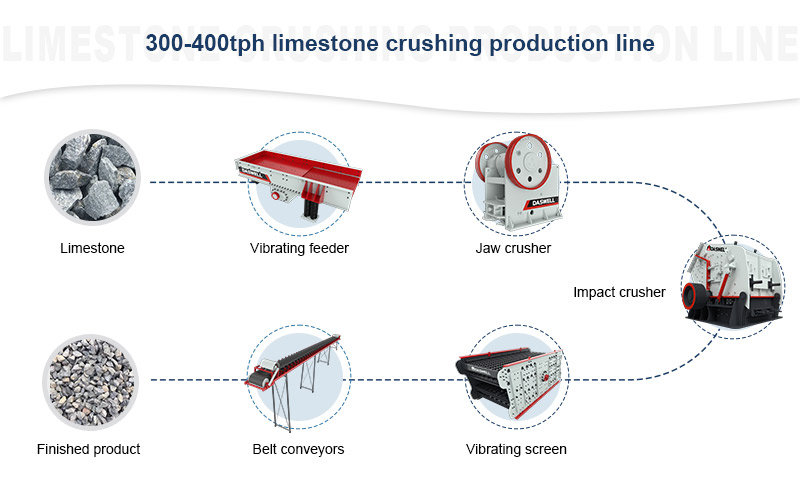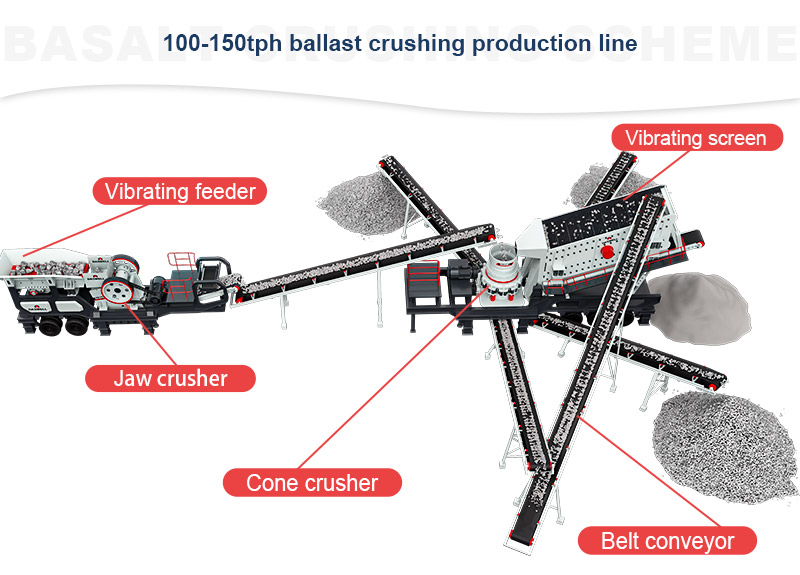As the demand for sand and gravel aggregate increases, more and more investors want to invest in a crushing production line to get more revenue. As we all know, there are many materials that can be used for crushing, and the corresponding production line configuration is different for different materials.
We need to understand the characteristics of the materials when configuring the production line, and then configure it according to the output and the inlet and outlet size requirements of the material.
This article summarizes the configuration scheme of aggregate crushing production line for 6 common materials, namely river pebble, granite, limestone, basalt, ballast and feldspar. If you have any questions, please contact us for consultation!

River pebble
River pebble characteristics
River pebble is a pure natural stone. It has experienced constant extrusion and friction in the process of flowing water. They have been beaten by waves and water, lost their irregular edges and corners due to the collision and friction of gravel, and have been buried deep underground for millions of years together with sediment.
The main chemical composition of river pebble is silica. It has the characteristics of hard quality, bright color, compression resistance, wear resistance and corrosion resistance, and is an ideal building material.

River pebble crushing technology
Generally speaking, river pebbles are mostly close to rivers and oceans. River pebbles are rich in resources, and the cost of collection is relatively low. Moreover, it has a beautiful appearance and is an ideal choice for stone used in courtyards, roads, building construction, etc.
In the river pebble crushing technology, most of the jaw crushers are used for primary crushing, and the cone crusher is used for secondary and tertiary crushing.
150-180tph river pebble crushing production line
Main equipment: raw material storage bin, vibrating feeder, jaw crusher, cone crusher, vibrating screen, sand washing machine, belt conveyor

Granite
Granite characteristics
Granite has a uniform structure, hard texture, beautiful color and durability. It is a high-quality building material. In construction, granite is used from roofs to floors, and if crushed, it can be made into cement or rock to fill dams.
Granite is not easy to be weathered, the color is beautiful, and the appearance color can be maintained for more than a hundred years. Besides being used as building decoration and hall floor, it is also an ideal material for open-air carving.

Granite crushing technology
Granite has the characteristics of hard texture, high strength, weathering resistance, corrosion resistance and abrasion resistance. Its crushing process is generally coarse crushing by a jaw crusher, and then medium and fine crushing by a cone crusher.
This not only has strong crushing strength, but also has less needle flakes. According to the needs of different customers, the vertical shaft impact crusher can also be used for sand making and shaping.
150-200tph granite crushing production line
Main equipment: raw material storage bin, vibrating feeder, jaw crusher, cone crusher, vertical shaft impact crusher, vibrating screen, belt conveyor

Limestone
Limestone characteristics
Limestone is a calcium carbonate rock mainly composed of calcite. After being mined, it is crushed to form limestone particles, namely stone and sand. Or it is further milled to form limestone powder, which is widely used in building materials, highways, metallurgy, chemical industry and other industries.
Limestone becomes calcium oxide CaO (common name quicklime) after being calcined. Quicklime is generally in the form of lumps and is used in water quality treatment, asphalt improvement, desulfurization, building materials, medicine and other industries. Quicklime absorbs moisture or adds water to become slaked lime. Its main component is calcium hydroxide Ca(OH)2, which is used in environmental protection, medicine, food and other industries.

Limestone crushing technology
Limestone is very rich in resources. The processing of limestone is mainly to produce quicklime, slaked lime, precipitated calcium carbonate, ultra-fine (nano) calcium carbonate, etc. through crushing, grading and other technologies. Due to the soft hardness of limestone, impact crusher can be used in secondary crushing, with low investment and high return.
300-400tph limestone crushing production line
Main equipment: raw material storage bin, vibrating feeder, jaw crusher, impact crusher, vibrating screen, belt conveyor

Basalt
Basalt characteristics
Basalt is an igneous rock formed by underground magma erupted from volcanoes or condensed from surface fissures. The main components of basalt are silicon dioxide, aluminum oxide, iron oxide, calcium oxide, etc. Among them, the silica content is the most, accounting for about 45 to 50 percent.
The common colors of basalt are mostly black, dark brown or dark green. Because of its dense texture, its specific gravity is heavier than that of general granite and limestone.

Basalt crushing technology
The Mohs hardness of basalt reaches 5 to 7, and the content of SiO2 is 45% to 52%. Therefore, the impact crushers aren’t generally used for crushing basalt, , but more cone crushers are used for the medium and fine crushing.
150-200tph basalt crushing production line
Main equipment: raw material storage bin, vibrating feeder, jaw crusher, cone crusher, vertical shaft impact crusher, vibrating screen, belt conveyor

Ballast
Ballast characteristics
Ballast is the crushed stone used to support track sleepers in the railway transportation system, and is a common track bed structure. Before laying the track, a layer of gravel will be laid on the subgrade and then compacted, and then sleepers and track will be laid.
Using ballast can make drainage easier, and it is also easy to adjust the rail position. At the same time, since the ballast disperses the weight of the train and the track on the roadbed, it can reduce the vibration and noise caused by the train passing by.

Ballast crushing technology
Ballast is the coarse gravel or crushed stone used to lay road or railway subgrades. Its stone quality is super granite, so its hardness is relatively high. When crushing raw materials, jaw crusher is generally selected as primary crushing, and cone crusher is used as secondary and third stage crushing.
100-150tph ballast crushing production line
Main equipment: vibrating feeder, jaw crusher, cone crusher, vibrating screen, belt conveyor

Feldspar
Feldspar characteristics
Feldspar is a common class of aluminosilicate rock-forming minerals containing calcium, sodium and potassium. It is also one of the most common minerals in the continental crust, accounting for up to 60 percent of the crust. Feldspar is often milky white, but it is often dyed into yellow, brown, light red, dark gray and other colors because of various impurities.
Feldspar rich in potassium or sodium is mainly used in ceramic industry, glass industry and enamel industry. The beautifully colored feldspar can be used as a decorative stone and as a secondary gemstone.

Feldspar crushing technology
The Mohs hardness of feldspar is between 6 and 6.5, which is a harder ore. Therefore, it is recommended to choose extrusion crusher when crushing, and such crushers like hammer crusher and impact crusher are not recommended. This is because in the later use, the loss generated by the equipment is very large.
Jaw crusher is used for coarse crushing, which can crush large feldspar to about 200mm size at one time, and then enter into cone crusher for fine crushing.
200-250tph feldspar crushing production line
Main equipment: vibrating feeder, jaw crusher, cone crusher, vibrating screen, sand washing machine, belt conveyor

Of course, even for the same material, if the output and inlet and outlet sizes are different, the configuration of the crushing line will be different. So, if you want to invest in a crushing production line, please leave your material type, output and inlet and outlet size. We will contact you as soon as possible to customize a suitable aggregate crushing production line solution for you.
